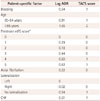1. Strong K, Mathers C, Bonita R. Preventing stroke: saving lives around the world. Lancet Neurol. 2007; 6:182–187.

2. Mead GE, Lewis SC, Wardlaw JM, Dennis MS, Warlow CP. How well does the Oxfordshire community stroke project classification predict the site and size of the infarct on brain imaging? J Neurol Neurosurg Psychiatry. 2000; 68:558–562.

3. Kwok CS, Potter JF, Dalton G, George A, Metcalf AK, Ngeh J, et al. The SOAR stroke score predicts inpatient and 7-day mortality in acute stroke. Stroke. 2013; 44:2010–2012.

4. Bamford J, Sandercock P, Dennis M, Burn J, Warlow C. Classification and natural history of clinically identifiable subtypes of cerebral infarction. Lancet. 1991; 337:1521–1526.

5. Tsai CF, Thomas B, Sudlow CL. Epidemiology of stroke and its subtypes in Chinese vs white populations: a systematic review. Neurology. 2013; 81:264–272.

6. Schmidt M, Jacobsen JB, Johnsen SP, Bøtker HE, Sørensen HT. Eighteen-year trends in stroke mortality and the prognostic influence of comorbidity. Neurology. 2014; 82:340–350.

7. Lackland DT, Roccella EJ, Deutsch AF, Fornage M, George MG, Howard G, et al. Factors influencing the decline in stroke mortality: a statement from the American Heart Association/American Stroke Association. Stroke. 2014; 45:315–353.

8. Reggiani M. Società Inter-Regionale Piemonte e Valle d'Aosta per le Cerebrovasculopatie Group. Five-year survival after first-ever ischaemic stroke is worse in total anterior circulation infarcts: the SINPAC cohort. Cerebrovasc Dis. 2009; 27:29–36.

9. O'Donnell MJ, Xavier D, Liu L, Zhang H, Chin SL, Rao-Melacini P, et al. Risk factors for ischaemic and intracerebral haemorrhagic stroke in 22 countries (the INTERSTROKE study): a case-control study. Lancet. 2010; 376:112–123.
10. Arnold M, Halpern M, Meier N, Fischer U, Haefeli T, Kappeler L, et al. Age-dependent differences in demographics, risk factors, co-morbidity, etiology, management, and clinical outcome of acute ischemic stroke. J Neurol. 2008; 255:1503–1507.

11. Myint PK, Clark AB, Kwok CS, Davis J, Durairaj R, Dixit AK, et al. The SOAR (Stroke subtype, Oxford Community Stroke Project classification, Age, prestroke modified Rankin) score strongly predicts early outcomes in acute stroke. Int J Stroke. 2014; 9:278–283.

12. Bettencourt-Silva J, De La Iglesia B, Donell S, Rayward-Smith V. On creating a patient-centric database from multiple Hospital Information Systems. Methods Inf Med. 2012; 51:210–220.

13. Farrell B, Godwin J, Richards S, Warlow C. The United Kingdom transient ischaemic attack (UK-TIA) aspirin trial: final results. J Neurol Neurosurg Psychiatry. 1991; 54:1044–1054.

14. Lim WS, van der Eerden MM, Laing R, Boersma WG, Karalus N, Town GI, et al. Defining community acquired pneumonia severity on presentation to hospital: an international derivation and validation study. Thorax. 2003; 58:377–382.

15. Kwok CS, Clark AB, Musgrave SD, Potter JF, Dalton G, Day DJ, et al. The SOAR stroke score predicts hospital length of stay in acute stroke: an external validation study. Int J Clin Pract. 2015; 69:659–665.

16. Saka O, McGuire A, Wolfe C. Cost of stroke in the United Kingdom. Age Ageing. 2009; 38:27–32.

17. Dewey HM, Thrift AG, Mihalopoulos C, Carter R, Macdonell RA, McNeil JJ, et al. Lifetime cost of stroke subtypes in Australia: findings from the North East Melbourne Stroke Incidence Study (NEMESIS). Stroke. 2003; 34:2502–2507.
18. Laloux P. Belgian Stroke Council. Cost of acute stroke. A review. Acta Neurol Belg. 2003; 103:71–77.
19. Warlow CP, Dennis MS, van Gijn J, Hankey GJ, Sandercock PA, Bamford JM, et al. Stroke: a Practical Guide to Management. Cambridge, MA: Blackwell Science;1996. p. 414–441.
20. Allen CM. Predicting the outcome of acute stroke: a prognostic score. J Neurol Neurosurg Psychiatry. 1984; 47:475–480.

21. Unsworth CA. Selection for rehabilitation: acute care discharge patterns for stroke and orthopaedic patients. Int J Rehabil Res. 2001; 24:103–114.

22. Agarwal V, McRae MP, Bhardwaj A, Teasell RW. A model to aid in the prediction of discharge location for stroke rehabilitation patients. Arch Phys Med Rehabil. 2003; 84:1703–1709.

23. Langhorne P, Stott DJ, Robertson L, MacDonald J, Jones L, McAlpine C, et al. Medical complications after stroke: a multicenter study. Stroke. 2000; 31:1223–1229.
24. Haeusler KG, Laufs U, Endres M. Chronic heart failure and ischemic stroke. Stroke. 2011; 42:2977–2982.

25. Colantonio A, Kasl SV, Ostfeld AM, Berkman LF. Prestroke physical function predicts stroke outcomes in the elderly. Arch Phys Med Rehabil. 1996; 77:562–566.

26. Huybrechts KF, Caro JJ. The Barthel Index and modified Rankin Scale as prognostic tools for long-term outcomes after stroke: a qualitative review of the literature. Curr Med Res Opin. 2007; 23:1627–1636.

27. Dallas MI, Rone-Adams S, Echternach JL, Brass LM, Bravata DM. Dependence in prestroke mobility predicts adverse outcomes among patients with acute ischemic stroke. Stroke. 2008; 39:2298–2303.








 PDF
PDF ePub
ePub Citation
Citation Print
Print


 XML Download
XML Download